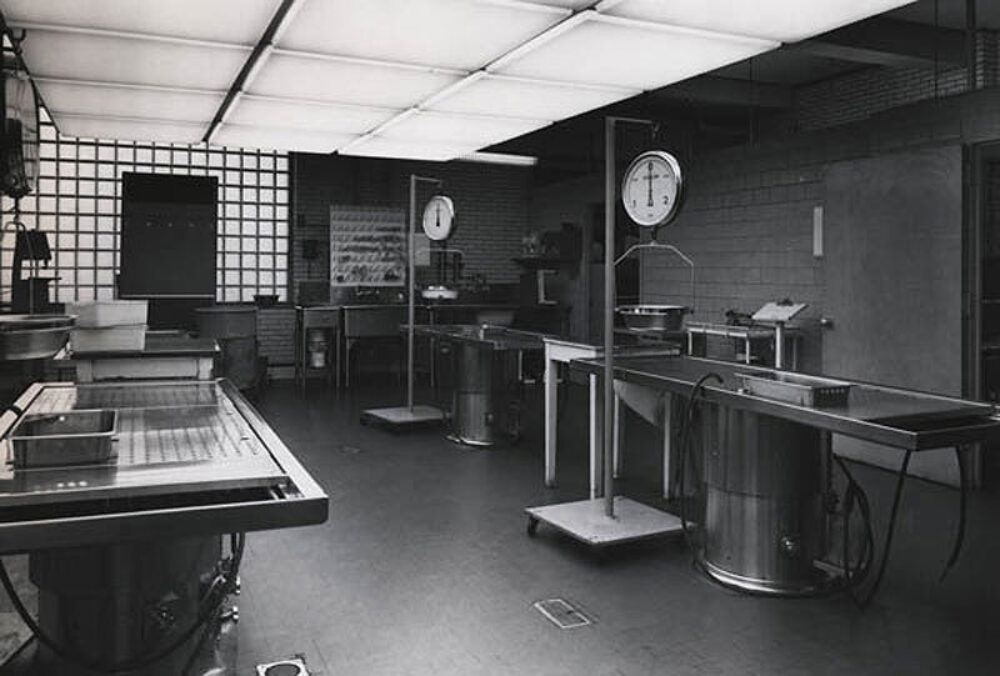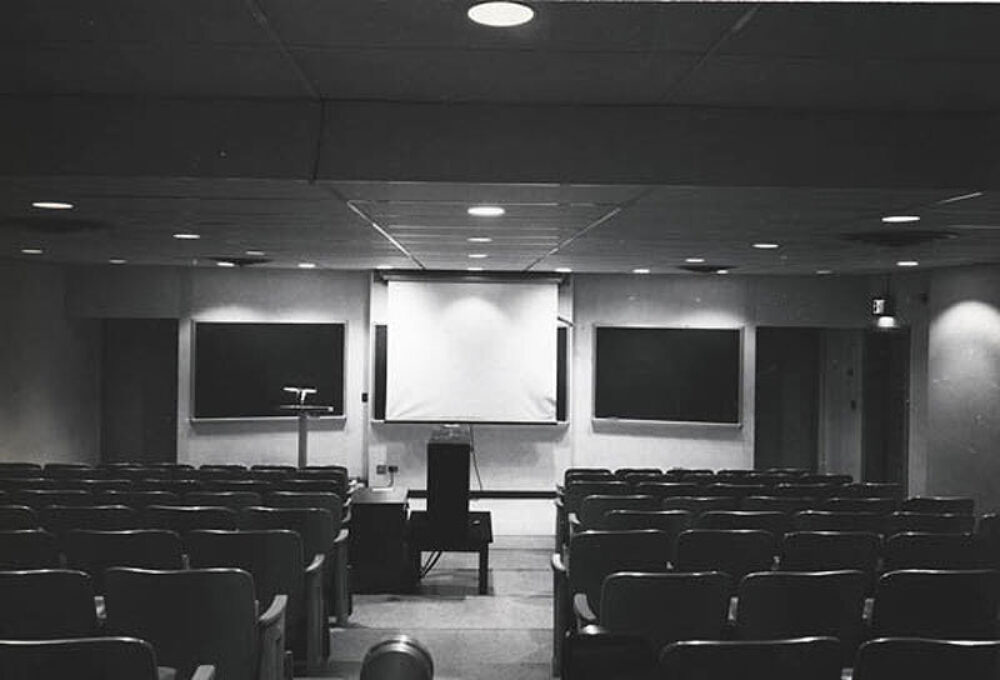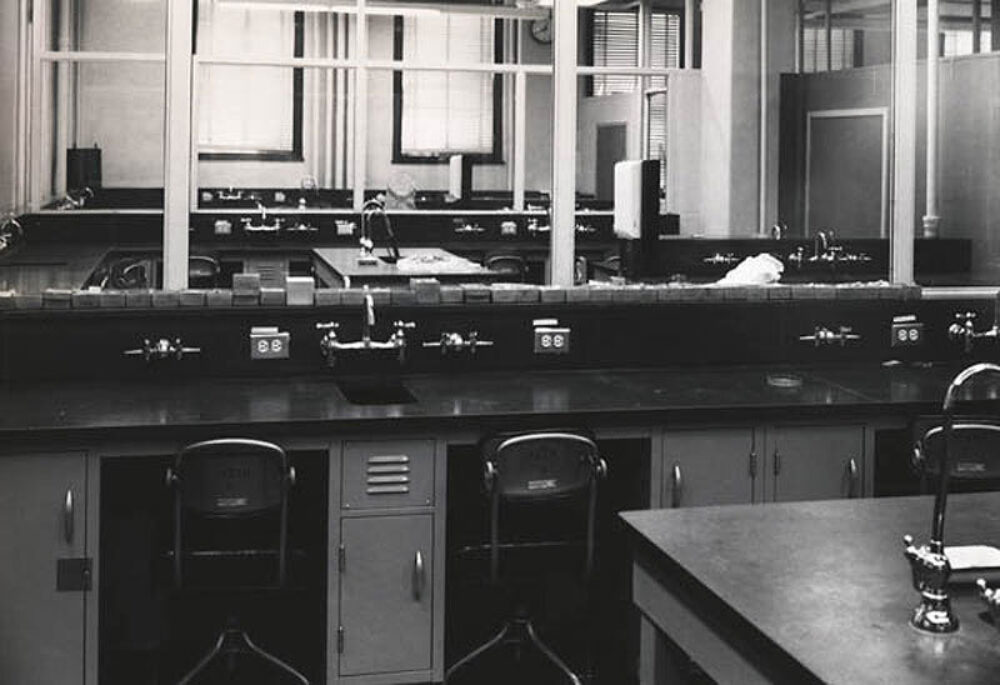
Pathology Department History
1931 - 1964
Written by Ella H. Oppenheimer, M.D. & Samuel H. Paplanus, M.D.
In the first index volume of the work of the Pathology Department, Dr. MacCallum summarized the growth of the Department from the opening of the laboratory by Dr. Welch in 1885 until 1930. This second index volume provides an author and subject index for reprint volumes XXIX through XXXVII, a roster of staff members for the years 1931 to 1965; and describes the further expansion of the Pathology Department for these years, highlighting the major changes and accomplishments.
In the first index volume of the work of the Pathology Department, Dr. MacCallum summarized the growth of the Department from the opening of the laboratory by Dr. Welch in 1885 until 1930. This second index volume provides an author and subject index for reprint volumes XXIX through XXXVII, a roster of staff members for the years 1931 to 1965; and describes the further expansion of the Pathology Department for these years, highlighting the major changes and accomplishments.
In 1930, Dr. MacCallum reported that a budget of $52,000 (including $9,000 for supplies and apparatus) cared for the activities and salaries of the 24 members of the staff, two secretaries, three histology technicians, two bacteriologists, one embalmer, one photographer and five laboratory and animal-care helpers. Today, in 1965, we have 65 pathologists in this Department with 24 secretaries, 41 laboratory technicians, three embalmers, two photographers and 17 laboratory helpers.
The money necessary to pay for this greatly increased operation is derived from several sources, each contributing about 1/3 of the income. The Hospital pays the residents and the costs of maintaining the autopsy, cytopathology and surgical pathology laboratories. The University pays all teaching expenses, including faculty salaries. Additional income is derived from 20 teaching and research grants and contracts from the U.S. Army, the National Institutes of Health, the American Cancer Society, and other organizations.
The 65 departmental pathologists include 24 full-time senior staff members, five of whom have joint appointments in other Johns Hopkins University departments and 12 who have staff appointments in other institutions (Baltimore City, Sinai and Union Memorial Hospitals of Baltimore; the Armed Forces Institute of Pathology of Washington and the Memorial Hospital of New York). There are 27 fellows in pathology (including 19 residents) and two active pathologists with emeritus standing.
The Pathology Department has several subdivisions. In 1964, 731 autopsies were performed by the autopsy service as compared to 529 in 1930. The division of Surgical Pathology has expanded to include biopsies from neurosurgery, the genitor-urinary service, and the Department of Gynecology. In 1964, there were 16,572 surgical specimens including 6,197 from genecology; in 1930 there were only 1,732 surgical specimens and an additional 1,215 gynecological biopsies, together less than one-fifth of the material examined in 1964. As before, the Departments of Dermatology and Ophthalmology continue to run separate pathology laboratories.
A major new division of the Department is Cytopathology, organized by Dr. John K. Frost in November, 1956. Its main activity is a cytopathological diagnostic service for material from the hospital in-patient and numerous outpatient services. The division has a training program for cytotechnologists. This is a 12-month course for a maximum of 12 students resulting in certification. In addition there is an annual Porstgraduate Institute for Pathologists in Clinical Cytopathology. This is a course for 46 registrants of national distribution and consists of two weeks in residence and a home study course.
Forensic Pathology was originally planned by Dr. MacCallum; an opportunity for our staff members and students to do specialized work in this field is now provided under an agreement with the Office of the Chief Medical Examiner of Maryland.
The most recent addition to the Department is a division of Comparative Pathology. Two veterinary pathologists are occupied in the study of spontaneous animal diseases which may serve as models for exploring human counterparts. A training program in comparative pathology will soon be available to physicians and veterinarians.
Additional divisions under development but requiring additional staff and space include Pediatric Pathology, Neuropathology, and Electron Microscopy.
In 1948, the bacteriology section of this Department was abolished and bacteriology is now a separate department (Microbiology) in the Medical School. Autopsy bacteriology is now performed in the hospital bacteriology laboratory.
In general, the residency training program of this Department conforms to the requirements of the joint committee on accreditation but we provide numerous additional facilities and opportunities to our trainees.
The training program extends over approximately four years. During the first year, Interns and Junior Assistant Residents serve as autopsy prosecutors; in their second year in residence, in addition to performing autopsies, they act as supervisors of autopsies done by the first-year interns and receive their introduction to Surgical Pathology.
During the third year as Senior Assistant Residents, a period of six months is spent in Surgical Pathology and a shorter period in Gynecologic Pathology. The remainder of the year is given to elective work in Cytopathology, Neuropathology, Electron Microscopy or other research. A fourth year of residency is spent as Chief Resident by one pathologist, but additional optional work is given to other residents who desire a longer tenure in the residency program.
A close relation has developed between this Department and the Memorial Hospital in New York. For each of the past several years, at least one resident from the Hopkins Pathology Department has gone to Memorial Hospital, receiving intensive experience in tumor pathology and thereby increasing his training period by an additional year.
Senior staff members have participated in exchange programs at foreign universities, especially in Lebanon, Peru, Africa, and India and several senior pathologists from abroad have spent periods in the Department here.
The housing of the large staff has been made possible by the continuing internal reconstruction of the Pathology Building. Radical changes from the original building described by Dr. MacCallum in 1930 have been made in the basement, first, and second floors. These include - autopsy room reconstruction, (first picture below), a new staff and student conference room, (second picture below), and alteration of the "gross pathology" teaching rooms on the first floor to staff offices and laboratories. On the second floor, a completely reconstructed student laboratory, (third picture below), includes facilities for the teaching of gross as well as histological pathology to six groups of 15 students each, segregated by partitioning walls.



The previous storage and unused space in the basement has been converted to the laboratory and office of the Electron Microscopy Division, under the direction of Dr. J. H. Yardley.
The third floor offices have been modernized as have many offices and laboratories throughout the remainder of the building. An important improvement is the enlargement of the photography facilities on the fourth floor which enables this section to provide ample photography service for autopsy gross and microscopic records, for slide demonstrations, for general and surgical pathology, and for research and publications.
The sixth floor has been almost completely reconstructed to house the Cytopathology Divison.
The members of the Pathology Department staff are listed herein by academic years from 1931 to present. It should be noted that in the early years the staff was composed of as many bacteriologists as pathologists. This accounts for the weighted interest in basic bacteriological research in that period.
There have been continuing waves of interest in various subjects through the years. Throughout the 1930s and early in the 1940s, Drs. MacCallum and Blackman made important contributions to the understanding of renal disease; recently with new techniques of study, including electron microscopy, X-ray microangiography, and fluorescence microscopy, a further elucidation of glomerular disease has been the subject of departmental publications.
Dr. Rich and his associates devoted many years to the definitive understanding of tuberculosis. As a result of these investigations the study of immunological processes assumed major importance in the Department and important contributions in this field were made especially by Drs. Rich and Germuth.
Dr. MacCallum became inactive with the onset of his incapacitation illness in 1941. Dr. Rich, who temporarily acted as head of the Department, became Baxley Professor in 1947. When Dr. Rich became emeritus professor in 1958, Dr. Bennett succeeded as the new Baxley Professor; and in 1960, a second professorship was established with Dr. Sheldon as the incumbent. Dr. Bennett has been continuing his research in the pathogenesis of fever, begun before he joined this Department; Dr. Sheldon has been pursing further work on basic mechanisms of inflammation.
Dr. MacCallum's last revision of his A Textbook of Pathology was completed in 1940 before the onset of his illness. His textbook is still considered to be the American classic.
Dr. Rich published his monumental Pathogenesis of Tuberculosis in 1944; this has since been translated into two languages. Dr. Folis, whose contributions in the field of pathology of bone and deficiency diseases are unparalleled, wrote a standard text on the pathology of nutritional diseases in 1948. This has been renamed Deficiency Disease in a later edition.
Other staff members have not only aided in the researches enumerated but have contributed to the understanding of many diverse conditions, as can be seen in the complete index of publications from this Department.
Written by Ivan L. Bennett, Jr., M.D.
The foregoing brief account of the activities of the Department of Pathology in the years since 1930 is accurate but, in one important respect, it is incomplete (and understandably so).
There is no mention of the extraordinary contributions of Dr. Ella H. Oppenheimer throughout these years.
From the day that Dr. MacCallum assigned to "Miss Oppenheimer" the task of compiling the first diagnostic index of the Department's autopsy files, she quietly assumed more and more responsibility for maintaining this index, for keeping departmental records, for scheduling the course for undergraduate students, and for assembling and reviewing the teaching collections, both gross and microscopic.
There is no doubt whatsoever in my mind that the quiet, efficient, unselfish devotion of this remarkable lady to these supposedly mundane but actually essential tasks has been the major factor in the continuing excellence of this Department. Through the years, many members of the staff have come and gone, some to become internationally famous for their research and academic accomplishments. All are in her debt and, furthermore, all know it and admit it. Dr. Oppenheimer has remained, holding the Department on course, and giving it substance, dependability, and continuity.
Although she became Mrs. Henry S. Miller and took time off to give birth to two children, she remained "Miss Oppenheimer" to Dr. MacCallum. I daresay that her work in the Department was less disrupted by the birth of her children than it was, in later years, when grandchildren began to make their appearance!
A devoted teacher, she has spent countless hours with students and with residents. She was (and still is) always available to look at an interesting slide or to work off a case. She has found time to make many contributions to the literature, particularly in her special field of interest, pediatric pathology. Most of these (save a few, long ago) are not the results of laboratory experiments but are derived from careful analysis and correlation of case material, made possible by her superb index.
Many is a resident she has reminded - first gently and then, failing a response - somewhat more vigorously - that he is behind in his cases. It is a fair comparison to say that she mothered us all along the way by whatever means a mother must use to keep the young (or not so young) in line.
"Miss Oppenheimer" she remained to Dr. MacCallum, "Dr. Oppenheimer" to students and residents, but to her colleagues on the staff, she was just "Ella." How she spoiled them! They took her records and schedules for granted only to learn later and elsewhere that these are the products of time, trouble, and devoted interest.
On innumerable occasions during visits to other University departments of pathology, I have had occasion to learn that Dr. Oppenheimer is properly appreciated elsewhere, even if we take her for granted at home.
Typical Comments:
- From a Department Chairman, formerly at Hopkins: "How's Ella?...what a wonderful woman...please give her my best regards."
- From a Department Chairman, never at Hopkins: "If only we had someone like your Dr. Oppenheimer..."
- From a Department Chairman, formerly at Hopkins: "You know, I never realized until I left Baltimore that she was the only one who really kept the Department going."
- From a Professor of Surgery, formerly at Hopkins: "She was the only person in that whole Department who was interested in the students more than in research..."
- From one of my many tormentors:: "What going to happen when Ella decides to quit? She's irreplaceable."
- From a Department Chairman, never at Hopkins: "If only we had someone like your Dr. Oppenheimer..."
- etc., etc., etc.
Throughout, she found time to run a large household, to raise children, and now, grandchildren, to collect shells, to garden, to sew, to design furniture, to dig fossils, to play golf, and, of course, to watch the Baltimore Orioles. And she does them all superlatively well!
Even Dr. MacCallum would have to admit that little Miss Oppenheimer grew up into one helluva woman!
